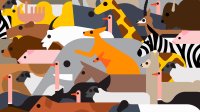How Animal Research Can Inspire Elementary Students’ Writing
Teachers can assess young students’ literacy skills and knowledge by encouraging them to produce books based on animal facts.
Your content has been saved!
Go to My Saved Content.After the spring break, something new, unexpected, and wonderful occurred in my first-grade class. Students started independently reading complex nonfiction texts about animals, writing notes, and then using them to write short nonfiction fact books, complete with quizzes. During morning meeting time, the students then requested to read their texts to the class. Once one student did this, others followed, and soon it inspired the whole class.
Begin with Research and An Extension Activity
In the first half of the year, I taught an integrated unit of writing and reading that involved learning how to construct nonfiction teaching books. I’ve often found that in younger grades, skills and knowledge tend to percolate and then pop back up at unexpected times. This was exactly what happened in the second semester with an unexpected flourish of animal fact books.
Every day we have a lesson that focuses on phonics instruction and decodable texts. One of my students is able to read two years ahead of his classmates, so the phonics work is not necessary for him. Because he is a TAG (Talented and Gifted) watchlist student, I wanted a meaningful and engaging activity that he could complete independently while the rest of us worked on our core phonemic awareness tasks.
So, I invited him to use the Epic book app on his school iPad to research anything he wanted. He dove into note-taking about prehistoric sharks. The next step was to give him a week to write his notes into a fully fledged nonfiction text, which he did. He then presented it to the class.
This occurred a couple of times before two other students asked for the same privilege. Since they were two more of my most confident and accomplished readers, I gave them the same opportunity, once they completed their phonics work. They did this quickly and accurately, motivated to research. Over the next month, these two students produced so many short books each that I lost count. Both students transferred the activity to home, creating texts that impressed their parents. One of the pair made books for her younger siblings.
Invite All Students to Research and Write
Now there were three students sharing numerous short animal fact books, and, of course, everyone in the class wanted to be a part of this process. I had an “enthusiasm management” issue. Fortunately, I was able to carve out some choice writing time for my first-grade class during the week that gave every student the chance to join in.
At the same time, my student president initiative was going strong. The student president had the right to decide on the activity for the last 10 minutes of the day. By far, the most popular choice was researching and making animal books. The class would cheer at the announcement! The pile of student-created animal fact books to share at the morning meeting grew higher and higher.
I’m a passionate reader and watcher of natural history documentaries, so I consider myself knowledgeable about the animal world. Yet, every day I was learning new and fascinating things about animals as diverse as tigers, sea sponges, woolly mammoths, seahorses, blue whales, and cottonmouth snakes!
Maintaining the Established Standard
As the quantity grew, the quality of writing in the texts started to slip. I found that some students were rushing their texts in order to be included in the sharing pile, desiring their moment of attention and achievement. So, I had to reassess the process and set the following conditions:
1. Texts needed to be complete, with introductions and sections with titles—just as we had learned in our writing unit in the first semester.
2. Note-taking from iPads had to be done properly, as the students had learned from our research unit.
3. Priority would be given to first-time sharers.
4. Neat (or at least neater, depending on the student) handwriting was required.
Highlight Excellent Work
Students who made the most effort with their text, including working on it at home, would have the opportunity to be featured in the school’s weekly film newsletter. This was run by the school librarian, and she gladly welcomed the chance to have a literary section from such young students. She was able to pair their class/home-made books with books she had in the library. Now first-grade students were teaching the entire school!
The first pair of students who had created so many books were offered the ultimate honor: a shelf in the library to host their creations! The only reason they didn’t take the librarian up on her offer was that they had already sold their animal fact books in a home-made neighborhood bookstore, raising money for the school PTA/Scholastic book fair. These young writers had a deep investment in books!
The Lesson Ends, But the Learning is Authentic
As the end of the school year came and the days flew by, busy with special events, last lessons, and other school celebrations, the desire to create the books fizzled out. Such are the rhythms of creativity and life in the classroom. However, what was so special was how the students had helped initiate and sustain an authentic experience to continue practicing their nonfiction reading and writing skills, while building better communication and presentation skills.
This activity also demonstrates to young learners that a literary skill isn’t finished just because a curriculum unit is over. We are teaching lifelong skills, and any chance in our lives to use them is an opportunity that must be taken.
